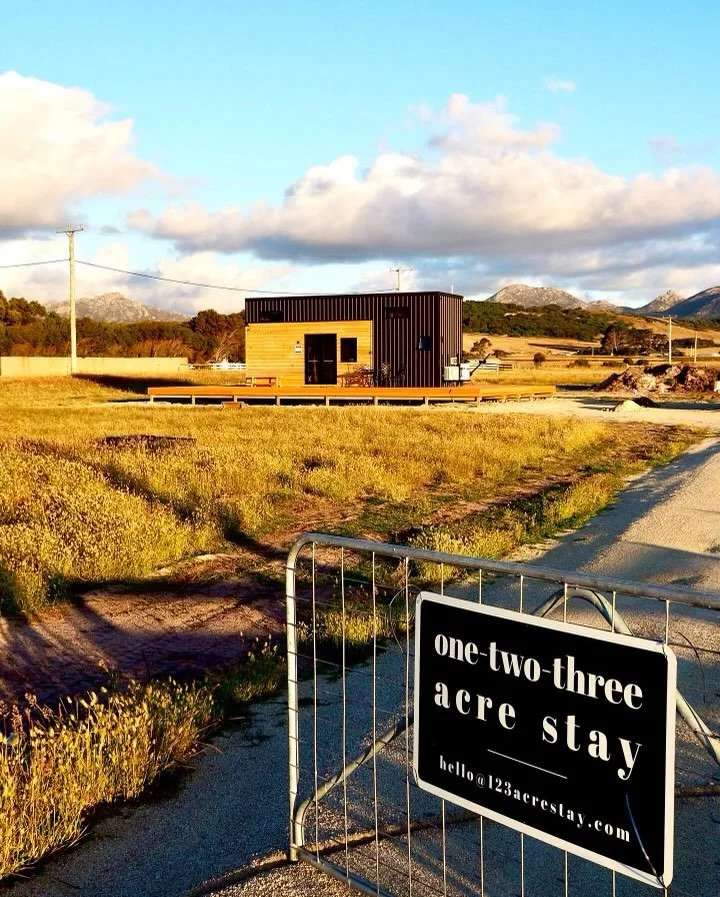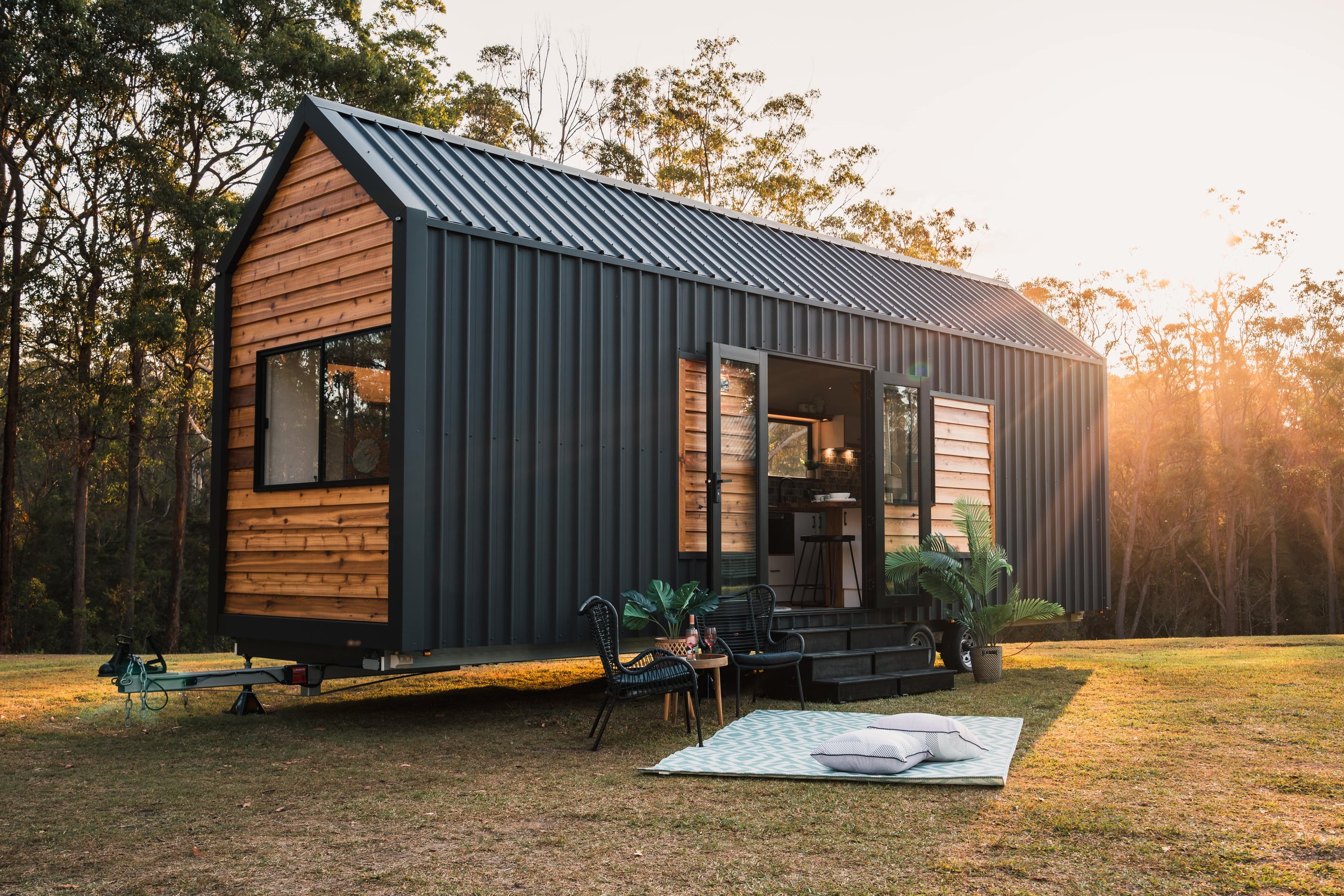Guide to buying a tiny house
Häuslein has built tiny houses for people all over Australia so we know what it takes to make the process of buying a tiny house as smooth as possible.
Two of our company founders living full time in a Grand Sojourner tiny house, so we also have the first-hand experience of what you need to know and what to expect.
We hope this free tiny house buyer’s guide will help you answer the most important questions.
This Häuslein Gunyah tiny house is tucked away on the Mid-North Coast.
1. Location
Do you have suitable land for your tiny house?
Finding the right place to park for your tiny house is critical. It’s one of the very first things you need to answer. Thankfully, it is achievable.
It could be as simple as searching on real estate websites for rural property or vacant blocks. But with with affordable land increasingly difficult to find close to built up areas, buying suitable land for your tiny house will be out of reach for many people.
However, you may not need to own the land. You can own your tiny house, but rent the land. A tiny house has the flexibility to be moved when your life or opportunities change, or you find land to own.
A growing number of people park their tiny houses in the backyard of a family member or friend. Multi-generational living is on the rise, bringing families closer together and sharing the cost of living and responsibilities such as childcare, paying the mortgage, managing the garden.
Other people rent land from land owners or farmers in the areas where they want to live.
Land for rental use for tiny houses is advertised on dedicated tiny house land matching websites such as Tiny Real Estate or Park My Tiny House or tiny house groups on Facebook.
We recommend you organise your land before ordering your tiny house build with Häuslein. It typically takes us 8-12 weeks to complete a build and have it ready for delivery.
Time to relax
2. Council regULATIONs
Do you need council approval?
One of the big attractions of tiny houses is that getting approval from your local council is usually not needed because your tiny house on wheels is technically a caravan.
In many cases, for residential or rural zoned land with an existing dwelling and enough space to put a tiny house – there should be no problem with council regulations and approvals. That is the simplest path to legally living in a tiny house is to place it on land where there already is an existing dwelling.
Generally, the less built up an area is, the less potential there is to run into red tape.
“I am just so grateful for everything you all have done for us. I look forward to more Häuslein Tiny Houses from you in the future.”
The attitudes at local councils are slowly improving as more people park their tiny houses on land across Australia.
If in doubt, it doesn’t hurt to call your local council to check.
There are some important caveats that are generally true across the country:
On a vacant block of land you can’t dwell in a tiny house on a permanent basis if that block of land does not have planning permission for a dwelling. Normally there’s a limit of 60 days per year and no more than 48 hrs at a time, thereby restricting use of tiny houses to weekender use only.
You will most likely be restricted from putting a tiny house on street frontage or driveway unless your dwelling is set back on the block.
You can’t park your tiny house too close to neighbours fence.
You can’t block a neighbour’s views.
If your neighbours are likely to object because of increased noise or then you should check with your local council.
You can park your tiny house on an easement because it is a moveable structure but you may need to move it temporarily if requested by council.
The Grand Sojourner model can be set up with a downstairs bedroom for kids or grown ups
3. Purpose
What will you use the tiny house for?
Each of our tiny house models are flexible and suitable for many different needs.
The Gunyah is designed for comfortably sleeping 2 guests and is ideal for using as weekend retreat or can be rented out for extra income on Airbnb.
If you want to live full-time in a tiny house or offer your guests a lot more room - then the Settler, Luna, Sojourner and Grand Sojourner models are much better options.
Our larger models have much more storage and appliances suitable for longer term living.
Get started by choosing one of our tiny house models, view layouts, specifications and optional extras for each model.
4. Storage
How much storage do you need?
Downsizing to a tiny house means that some compromise is inevitable. Thankfully, our ergonomic designs and storage solutions are built for day to day practicality. Every square inch of the tiny house floor plan has been thought about.
Customers love our unique and innovative slide-out feature which expands the internal space and helps to reorientate the layout of the house. Think of it as adding an extra 1 metre to the length of the house, but place it on the side.
Inside the house we have designed storage space under the stairs, in the kitchen cabinets, shelving, and wardrobe.
Finally, under the house and the optional deck & awning there’s more space for storing camping chairs, kayaks, surfboards, gardening tools etc. Beyond the house, there’s nothing to stop you from erecting a shed.
5. Power
How will you power your tiny house?
Our entire range of tiny houses are versatile, capable of connecting to the grid or going off grid. All of the appliances, power points and lighting are wired to run on a 240v circuit – the same as a normal residential house.
Our tiny houses are plug and play. You can run an extension power cable across to your tiny house from an existing dwelling to connect with your tiny house’s 15 amp inlet plug.
Your location, how often you’ll be in the tiny house, what appliances you’ll have running, all feed into how big your off grid system needs to be.
If you don't have the option for mains power or would like to go off-grid, you'll need to consider the appliances you'll be running. The initial outlay of an off grid solar power system can be considerable but with current energy prices, it's definitely worth considering or saving for. Feel free to ask our friendly sales team basic questions or contact your local off-grid power specialist to successfully size up the right off grid system.
“It has been a real pleasure working with everyone at Hauslein. My friends are all really impressed! The communication has been excellent, keeping me updated, the attention to detail and so on. What a great project it is, and so well managed.”
6. Water & Drainage
How will you supply your tiny house with running water?
Every tiny house needs a steady supply of clean water for the kitchen and bathroom. This couldn't be easier if you're on a block with mains water already available. Simply connect a normal garden hose to the plumbing at the back end of the tiny house, the same as you would with a caravan and you're good to go.
If mains water isn't an option, an off grid water system might be for you. This isn't normally hugely expensive but you'll need to purchase a few components. Make sure you seek advice from a plumber and have your system professionally installed.
Firstly, you'll need some guttering to catch your rain water. Monument matte colorbond guttering, to match in with your tiny house, is normally available anywhere you can purchase colorbond. You'll also need a water tank and a water pump, the pipes to connect it all together and the power required for the pump. You'll likely want a 5,000L water tank or greater. Your tiny house roof space isn't huge so unless you're in a high rain area, you might struggle to get enough water for daily use from only that source. Collecting water from a nearby shed can also help or you can buy water in to get you started.
You'll also need to think about where your grey water is going to go. All the sinks and shower in Häuslein tiny houses are plumbed to the same point which can then be plumbed into an existing septic tank by a plumber. Again, if an off-grid solution is required, there are some excellent off-grid drainaage systems available. They will usually include a grease trap and trench with slotted pipe laid down hill with layers of gravel to filter the grey water. If your waste water is being dispersed in the ground, you'll also want to be careful to be using environmentally friendly soaps, laundry liquids and other products.
It would normally take a plumber within a day to get you going with water tank, drainage and associated infrastructure. Not a huge cost but important to keep in mind.
7. Rubbish Collection
How will you deal with waste and rubbish collection?
Largely this decision will be driven by where you install your tiny house. If you place your tiny house on land where there is an existing dwelling connected to sewage pipes then your tiny house can be plumbed in with a regular flush toilet. If you choose to go fully off grid, a composting toilet solution, gas incinerator, and electric incinerator, are viable options for dealing with waste. Arrange for a local plumber to fit off your toilet.
If you're parking your tiny house on a property with others you'll need to make sure you have adequate rubbish collection. You may or may not manage sharing the typical council supplied wheelie bins. Often the property owner can order an extra bin and pay a little extra for its pickup.
If you're way out in the sticks, you may need to purchase some bins and do your own tip runs. Just ensure you know how you're handling your waste and the options in your location are.
8. Delivery & Installation
How far away is your delivery site?
Häuslein have delivered tiny houses to customers all over Australia. Delivery is measured from our base in Herons Creek 20 mins south of Port Macquarie. We provide our customers with a competitively priced quote for delivery.
Good access for tiny house delivered is important. We have delivered to many tight spots and difficult driveways. We've worked with external crane companies to have tiny houses craned to site. As a minimum your access road needs to be 3m wide with 4.3m high clearance. Overhanging trees will need to be trimmed back.
You’ll need a clearing with a flat level area to park your tiny house. A concrete slab is a nice-to-have but not required. You can use concrete pads or compacted crusher dust / road base to support the stabilising landing legs under your house.
We offer installation an optional extra, where we level your tiny house onto individually adjustable peers or landing legs and brace your tiny house for maximum stability. If you're confident or know someone who is able to do this for you, you can organise this yourself.
One unique feature that our customers love is our removable drawbar. Once the house is set up it makes your tiny house look more presentable and makes it harder for theft or unauthorised transportation.
Need help?
As part of our sales process we offer site inspections via video and assess the delivery route to make sure your tiny house location is viable before going ahead.
9. MovING
How transportable do you need your tiny house to be?
Our tiny houses are on wheels so they are designed to be mobile if needed. It’s one of the best features of a tiny house. When you need to move, it can be towed away with you.
However, most of our customers don’t move their tiny house once it has been installed. Most people don't keep their tiny houses road-registered. If you do need to transport your house at a later date, a permit to move an unregistered vehicle can be acquired from Service NSW or equivalent in other States at a low cost.
The 5m Gunyah weighs 3 tonnes making it towable by many powerful 4WD’s. Our larger 8m Sojourner and 9m Grand Sojourner models weigh between 4.0 - 4.5 tonnes making towing only possible by tow truck, Dodge Ram, Ford F Trucks type vehicles graded to tow 4.5 tonnes. For up to date pricing on delivery, check out our Delivery page.
10. Ordering & Finance
How will you pay for your tiny house?
Tiny houses on wheels are a new and innovative housing solution to Australia. Thankfully, arranging finance is getter better, even if you need to borrow more than $70k. Speak to us to arrange finance options.
You may be able to borrow the entire amount of your build with no deposit down and affordable monthly repayments.
Once you accept the formal quote you pay a $5k deposit which secures your place in the build queue. Then you’ll sign your build contract and when your build is ready to commence 40% of the contract will get paid. After that, there are two 30% progress payments until the build is completed.
To keep you updated we’ll send you photos of your tiny house during each stage of the build process.
Ready to build
Our expert team of tiny home builders are ready to build and deliver your tiny house.


















